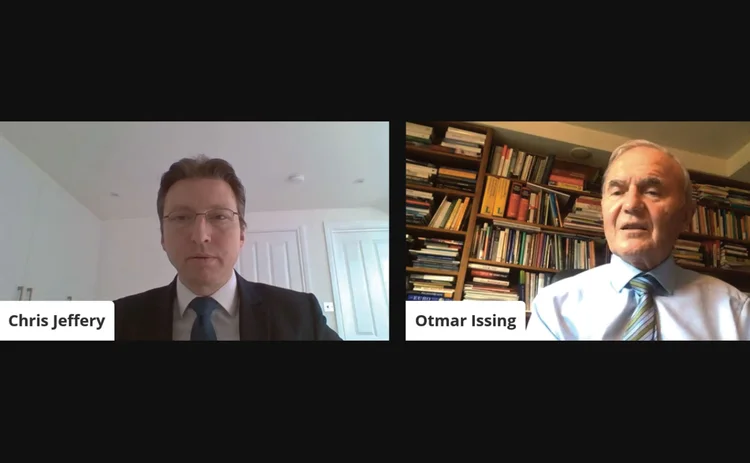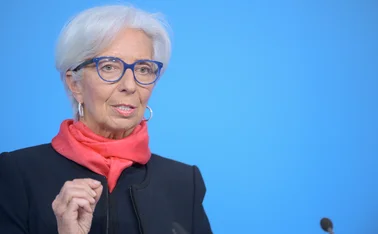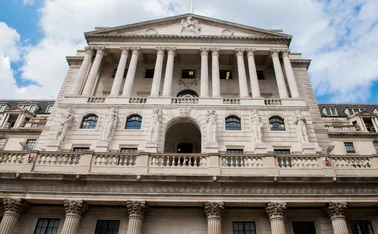
ECB is caught in a ‘communications trap’ – Issing
Monetary policy architect says ‘close to’ 2% inflation target was never part of original plan

The decision by the European Central Bank (ECB) to redouble its efforts to raise inflation closer to its 2% target has led the central bank into a “communications trap”, according to the institution’s first chief economist, Otmar Issing.
The ECB signalled its renewed intent to raise eurozone inflation towards 2% in the second half of 2019, after which it unveiled additional asset purchases – a move instigated by outgoing president Mario Draghi. It came at a time when the neutral rate of interest had fallen in most advanced economies, but preceded the global economic slump caused by Covid-19, which resulted in all advanced economies pursuing extraordinarily loose monetary policies at the same time.
“With inflation strongly below 2% for so many years, the ECB has explained that it will try to bring back the inflation rate closer to this 2%. This was interpreted as missing the mandate. I think, through this announcement, the ECB fell into a communication trap. Because they must have been aware that there was no chance to achieve that over the next one to three years,” Issing told Central Banking in an interview published on December 6.
Issing designed the ECB’s original monetary policy operating framework back in October 1998, by proposing the ECB’s Governing Council maintain its price stability mandate via “an average annual inflation rate of below 2%” over the medium term. This subsequently was amended in 2002, while Issing still served at the ECB, to include the words ‘below, but close to, 2%’. The ‘medium term’ has never been specifically defined, with central bankers only saying it depends on the transmission mechanism and the time lags, which might be long and variable.
Issing said three groups opposed his original 1998 proposal: those that did not want a numerical target, those that thought keeping inflation below 2% was too ambitious a target, and those that worried the ECB would be forced to take instant accommodative action to raise the eurozone’s harmonised consumer price inflation, which stood at around 1% at the time. “Announcing this ‘below 2%’ might be misunderstood as the intention of the ECB to bring up inflation as soon as possible,” Issing said the third group of objectors told him.
Ultimately, Issing’s proposal was accepted and there was no immediate effort taken to rush inflation up towards 2%. “I am a bit more explicit about that now because this is behind so many misunderstandings,” Issing said.
Issing believes that in more recent years, the ECB could have explained that “close to 2%” was its goal, but that it could “live with” a situation of lower inflation for some time. He said the ECB could have stated this “represented price stability”, it raised “no risk of deflation”, and that the central bank was “satisfied with the situation for the time being”. This would have avoided the “the impression that the ECB would miss its mandate”, Issing added.
Growing credibility risk
Issing believes there is now a “general problem” of central banks risking their credibility should they fail to match deeds to their words. This is a particular problem given their room for accommodative monetary policy is becoming more limited, as has been witnessed in Japan. It may also now be a risk for the Federal Reserve as it pursues its new average inflation target.
One potential solution, as raised by former International Monetary Fund managing director Jacques de Larosière in 2019, is for central banks to consider lowering their inflation targets to say 1–1.5%.
But Bank of Finland governor and ECB Governing Council member Olli Rehn told Central Banking last month that policy-makers should not “throw the towel to the ring” when it comes to trying to raise inflation.
“There’s been some discussion among some economists about lowering the target to 1%, given the fall in the neutral rate. In my view, it would be a mistake. I don’t think any central bank has seriously considered giving up its goals because of the current low inflation pressures,” Rehn said.
Rehn supports altering the ECB’s policy framework to create “a 2% symmetric point target” supplemented with a reaction function that delivers “sufficiently forceful and equally effective” policy reactions “to deviations of inflation from the target to both directions”. He adds: “This would be a move towards flexible average inflation targeting, somewhat along the lines that the Fed has decided over the summer. In my view, this policy would also serve the ECB and the euro area well.” The ECB is expected to complete its strategy review at some point next year.
But Issing is sceptical: “I am very critical of this approach, because the Fed has not made clear how long it will go back to measure the undershooting of inflation, and how long it will tolerate overshooting the 2%, and at what inflation rate it will stop the process of overshooting. Guiding and anchoring expectations by this approach, to me, is a very doubtful undertaking. The ECB should think twice before following that.”
Only users who have a paid subscription or are part of a corporate subscription are able to print or copy content.
To access these options, along with all other subscription benefits, please contact info@centralbanking.com or view our subscription options here: http://subscriptions.centralbanking.com/subscribe
You are currently unable to print this content. Please contact info@centralbanking.com to find out more.
You are currently unable to copy this content. Please contact info@centralbanking.com to find out more.
Copyright Infopro Digital Limited. All rights reserved.
As outlined in our terms and conditions, https://www.infopro-digital.com/terms-and-conditions/subscriptions/ (point 2.4), printing is limited to a single copy.
If you would like to purchase additional rights please email info@centralbanking.com
Copyright Infopro Digital Limited. All rights reserved.
You may share this content using our article tools. As outlined in our terms and conditions, https://www.infopro-digital.com/terms-and-conditions/subscriptions/ (clause 2.4), an Authorised User may only make one copy of the materials for their own personal use. You must also comply with the restrictions in clause 2.5.
If you would like to purchase additional rights please email info@centralbanking.com







